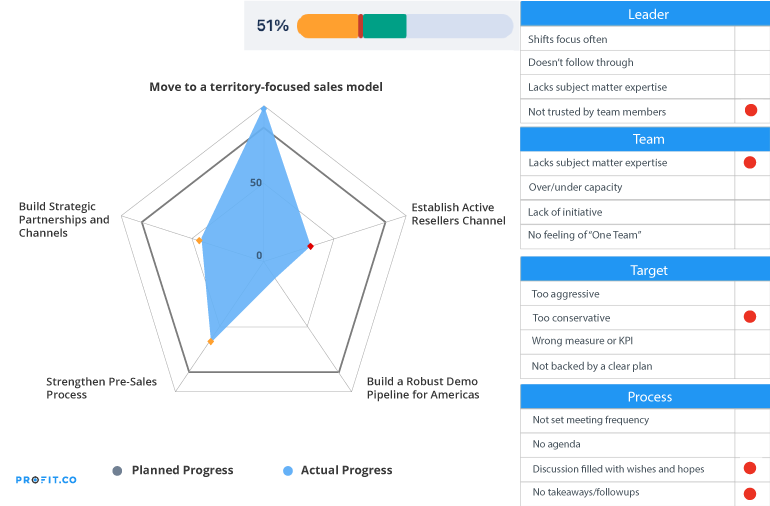Even when we do everything right when setting our OKRs and getting started with our OKR quarter, we can still face issues with progress.
The radar chart in Profit.co gives you a visual representation of OKR progress for a team, department, or company’s OKRs. When this chart is unbalanced, it’s a sign that there’s something amiss in one of four areas– the Leadership, the Team, the Target, or the Processes behind OKR progress. We’ve outlined 16 potential reasons that OKR progress is unbalanced in this article.
Effectively, change is almost impossible without industry-wide collaboration, cooperation, and consensus.
Below, we’ll explore a case study of unbalanced progress. Here, we have a sales department’s five OKRs for quarter three, which is just a few weeks away from ending, as signified by the black outline. This represents where progress should be at this point in the quarter, which would place all OKRs on track to be completed by the end of the quarter- signified by the larger pentagon created by the five OKRs.
As you can see by the blue shaded OKR progress area, OKR progress isn’t on track.

Three OKRs have an “At Risk” status, as indicated by the orange points. One has an “In Trouble” status, as indicated by the red point. Finally, one OKR is “Complete,” as indicated by the green point already at the outside of the pentagon.
Why the imbalance? Let’s break down how our potential reasons for unbalanced OKR progress are making an appearance on the Sales department’s radar chart.
Discussion Filled with Wishes & Hopes
Process issues are incredibly impactful and harmful when it comes to making consistent and proper progress on your OKRs. For the second OKR on this radar chart, “Establish Active Reseller’s Channel,” the sales team may have set up concrete key results revolving around demos and deals. However, even though these tangible key results and associated KPIs are in place, the sales team is still falling short.
This might come down to the discussion that department members are engaging in during meetings regarding this OKR. Even if a meeting is on the schedule and an agenda is in place, the discussion might lack agency and direction. Instead, the sales department could be talking less about tangible KPIs and more about wishes and hopes. These conversations are useless without concrete action items. If there is no task to complete, there is no movement on a key result, leading to a lack of progress on the OKR as a whole.
No Takeaways, No Follow-Ups
A process issue like insubstantial discussions can lead to further issues. If the sales department is having unfruitful discussions, chances are there is very little that team members can take away from the meeting itself– and very little for peers and leaders to follow up on. Checking up on progress is difficult when there isn’t an item to actually make progress on.
Instead, meetings need to be filled with action items, deadlines, or tasks. Otherwise, the OKR to “Establish Active Reseller’s Channel” will stall, just like we see on this radar chart.
Too Conservative
Let’s take a look at the first OKR on this radar chart, “Move to a territory-focused sales model”. The progress for this OKR is complete. When progress is unbalanced like this, and there is one OKR leagues ahead of others, it’s important to take a close look at the outlier.
With this OKR, you might find that it has been complete for weeks. Why is this the case?
It could be that the targets associated with this OKR were too conservative. With this example to change the sales model, it’s possible that the Sales department ran into an issue with sandbagging. Sandbagging is when individuals set their targets low so that they will undoubtedly achieve them. This makes them look better, and makes it appear as though they are excelling at achieving their OKRs.
When this happens, take a close look at the OKR. In this case, if the key results revolved around generating new leads, or creating new sales territory business plans, were they ambitious enough? Do the completion of the key results truly set the sales team up for success next quarter, when they begin selling in these territories?
This is an important habit for leaders to catch onto, and an even more important one to break in a department. While sandbagging might help a department look good at the end-of-quarter meeting, it certainly won’t turn out well in the long run, when they’re not well-prepared for what lies ahead. It’s also important to note that OKRs should not be tied directly to performance reviews, promotions, or pay raises– this gives team members reason to set the bar low and achieve high.
Ready to start your OKR Journey for FREE?
Lacks Subject Matter Expertise
Take a look at the fifth OKR in this case study example; “Establish Strategic Partnerships and Channels”. This OKR has made some progress, but lags behind planned progress, and has an “At Risk” status.
If the leader of this OKR is someone who lacks expertise in establishing partnerships, the OKR progress might look something like this. Partnering in business is incredibly important, and it isn’t necessarily easy. Establishing positive relationships with other sellers and solidifying that partnership isn’t a natural-born skill, and if the individual responsible for doing this isn’t experienced, efforts can fall flat time and time again.
When OKRs like this are lagging behind, it’s good practice to look into the individuals responsible for each key result. Are the assignees fit for the job? What is their background with this specific skill? When leadership asks these questions early on, they can assign another, more experienced individual to the key results and create a learning opportunity for the inexperienced individual, as well as maintain progress on important initiatives.
Not Trusted by Their Team
When OKRs are “In Trouble,” there is usually a strong reason behind it.
One that many leaders might not think of is the relationship between leadership and the team members responsible for an OKR. The third OKR in this case study, “Build a Robust Demo Pipeline for the Americas” might be paired with concrete key results, however progress is still not moving.
This might be due to a lack of trust in the leadership. This might stem from a number of reasons– it could be that the leader has a lack of confidence when communicating with the team, they lack knowledge in how to drive this OKR, or they don’t follow through on projects when the team needs them to.
If the team feels that they don’t have the support they need to drive an OKR, progress can stall. Establishing a demo pipeline can involve many moving parts and can be a large time commitment for individuals. If they feel their team leader won’t listen to them when they explain their bandwidth, or will not provide the right resources to help them achieve, they might not even be motivated to budge this OKR any more than they can with day-to-day activities.
Final Thoughts
Profit.co’s radar chart feature gives you the ability to see OKR progress at any point in the quarter, however it’s up to you to look closer and decipher what the causes are behind any unbalanced progress.
Using case studies to help understand what different potential issues may look like is a great practice for leaders and team members alike.
Unbalanced OKR progress should always be monitored, and the practice surrounding planning, executing, engaging, and learning from OKRs should be continually revisited and improved from quarter to quarter. If an issue appears in quarter one, take the time to examine and resolve it, so that they very same one won’t come back to haunt you in quarter three.
Identifying the issues you’re facing in your OKR Program is the first step to building a stronger OKR culture within your company. The most important aspect of OKRs is the learning process– building on past learnings and making sure that you adjust these issues is the best way to ensure future success. If you’ve identified your issues, but aren’t sure where to start on your journey to solving them, go ahead and return to your OKR basics. Start from the foundation of your OKR program and work your way up to the specific issues you see in your business. Each quarter will bring you closer to amazing strategy and execution with OKRs!
This unbalanced OKR progress series has hopefully provided a comprehensive look at what unbalanced OKR progress looks like, the reasons lurking behind it, and given you the skills to recognize issues as they arise.
To see how these issues play out in real life, take a look at a series of examples that we have created for demonstrating unbalanced progress at different levels with interesting case studies!
- Unbalanced Progress: What’s Going Wrong?: Take a look at Profit.co’s radar chart, what you can do during your planning process to help prevent unbalanced progress, and what it means for your organization in this first article in the Unbalanced Progress series.
- 16 Reasons your OKR Progress is Unbalanced: In this article, share the top reasons your OKR progress might be unbalanced and the causes hiding behind these effects.
- Solving Unbalanced progress at the corporate level: This case study explores five OKRs set at corporate level and how issues with the team and target can impact OKR progress.
- Solving Unbalanced Progress: Marketing Department Imbalance: This case study examines six OKRs at the marketing level and the issues that are causing an imbalance of OKR progress, as shown by the Profit.co radar chart.

